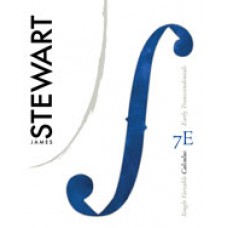Test Bank for Single Variable Calculus Early Transcendentals, 7th Edition
$35.00 Original price was: $35.00.$26.50Current price is: $26.50.
Test Bank for Single Variable Calculus Early Transcendentals, 7th Edition
This is completed downloadable of Test Bank for Single Variable Calculus Early Transcendentals, 7th Edition

Product Details:
- ISBN-10 : 0538498676
- ISBN-13 : 978-0538498678
- Author: James Stewart
Success in your calculus course starts here! James Stewart’s CALCULUS: EARLY TRANSCENDENTALS texts are world-wide best-sellers for a reason: they are clear, accurate, and filled with relevant, real-world examples. With SINGLE VARIABLE CALCULUS: EARLY TRANSCENDENTALS, Seventh Edition, Stewart conveys not only the utility of calculus to help you develop technical competence, but also gives you an appreciation for the intrinsic beauty of the subject. His patient examples and built-in learning aids will help you build your mathematical confidence and achieve your goals in the course!
Table of contents
-
Licensing
-
1: Functions and Models
- 1.1: Four Ways to Represent a Function
- 1.2: Mathematical Models- A Catalog of Essential Functions
- 1.3: New Functions from Old Functions
- 1.4: Exponential Functions
- 1.5: Inverse Functions and Logarithms
-
2: Limits and Derivatives
- 2.1: The Tangent and Velocity Problems
- 2.2: The Limit of a Function
- 2.3: Calculating Limits Using the Limit Laws
- 2.4: The Precise Definition of a Limit
- 2.5: Continuity
- 2.6: Limits at Infinity; Horizontal Asymptotes
- 2.7: Derivatives and Rates of Change
- 2.8: The Derivative as a Function
-
3: Differentiation Rules
- 3.1: Derivatives of Polynomials and Exponential Functions
- 3.2: The Product and Quotient Rules
- 3.3: Derivatives of Trigonometric Functions
- 3.4: The Chain Rule
- 3.5: Implicit Differentiation
- 3.6: Derivatives of Logarithmic Functions
- 3.7: Rates of Change in the Natural and Social Sciences
- 3.8: Exponential Growth and Decay
- 3.9: Related Rates
- 3.10: Linear Approximations and Differentials
- 3.11: Hyperbolic Functions
-
4: Applications of Differentiation
- 4.1: Maximum and Minimum Values
- 4.2: The Mean Value Theorem
- 4.3: How Derivatives Affect the Shape of a Graph
- 4.4: Indeterminate Forms and l’Hospital’s Rule
- 4.5: Summary of Curve Sketching
- 4.6: Graphing with Calculus and Calculators
- 4.7: Optimization Problems
- 4.8: Newton’s Method
- 4.9: Antiderivatives
-
5: Integrals
- 5.1: Areas and Distances
- 5.2: The Definite Integral
- 5.3: The Fundamental Theorem of Calculus
- 5.4: Indefinite Integrals and the Net Change Theorem
- 5.5: The Substitution Rule
-
6: Applications of Integration
- 6.1: Areas Between Curves
- 6.2: Volumes
- 6.3: Volumes by Cylindrical Shells
- 6.4: Work
- 6.5: Average Value of a Function
-
7: Techniques of Integration
- 7.1: Integration by Parts
- 7.2: Trigonometric Integrals
- 7.3: Trigonometric Substitution
- 7.4: Integration of Rational Functions by Partial Fractions
- 7.5: Strategy for Integration
- 7.6: Integration Using Tables and Computer Algebra Systems
- 7.7: Approximate Integration
- 7.8: Improper Integrals
-
8: Further Applications of Integration
- 8.1: Arc Length
- 8.2: Area of a Surface of Revolution
- 8.3: Applications to Physics and Engineering
- 8.4: Applications to Economics and Biology
- 8.5: Probability
-
9: Differential Equations
- 9.1: Modeling with Differential Equations
- 9.2: Direction Fields and Euler’s Method
- 9.3: Separable Equations
- 9.4: Models for Population Growth
- 9.5: Linear Equations
- 9.6: Predator-Prey Systems
-
10: Parametric Equations And Polar Coordinates
- 10.1: Curves Defined by Parametric Equations
- 10.2: Calculus with Parametric Curves
- 10.3: Polar Coordinates
- 10.4: Areas and Lengths in Polar Coordinates
- 10.5: Conic Sections
- 10.6: Conic Sections in Polar Coordinates
- Index
-
11: Infinite Sequences And Series
- 11.1: Sequences
- 11.2: Series
- 11.3: The Integral Test and Estimates of Sums
- 11.4: The Comparison Tests
- 11.5: Alternating Series
- 11.6: Absolute Convergence and the Ratio and Root Test
- 11.7: Strategy for Testing Series
- 11.8: Power Series
- 11.9: Representations of Functions as Power Series
- 11.10: Taylor and Maclaurin Series
- 11.11: Applications of Taylor Polynomials
-
12: Vectors and The Geometry of Space
- 12.1: Three-Dimensional Coordinate Systems
- 12.2: Vectors
- 12.3: The Dot Product
- 12.4: The Cross Product
- 12.5: Equations of Lines and Planes
- 12.6: Cylinders and Quadric Surfaces
-
13: Vector Functions
- 13.1: Vector Functions and Space Curves
- 13.2: Derivatives and Integrals of Vector Functions
- 13.3: Arc Length and Curvature
- 13.4: Motion in Space- Velocity and Acceleration
-
14: Partial Derivatives
- 14.1: Functions of Several Variables
- 14.2: Limits and Continuity
- 14.3: Partial Derivatives
- 14.4: Tangent Planes and Linear Approximations
- 14.5: The Chain Rule
- 14.6: Directional Derivatives and the Gradient Vector
- 14.7: Maximum and Minimum Values
- 14.8: Lagrange Multipliers
-
15: Multiple Integrals
- 15.1: Double Integrals over Rectangles
- 15.2: Double Integrals over General Regions
- 15.3: Double Integrals in Polar Coordinates
- 15.4: Applications of Double Integrals
- 15.5: Surface Area
- 15.6: Triple Integrals
- 15.7: Triple Integrals in Cylindrical Coordinates
- 15.8: Triple Integrals in Spherical Coordinates
- 15.9: Change of Variables in Multiple Integrals
-
16: Vector Calculus
- 16.1: Vector Fields
- 16.2: Line Integrals
- 16.3: The Fundamental Theorem for Line Integrals
- 16.4: Green’s Theorem
- 16.5: Curl and Divergence
- 16.6: Parametric Surfaces and Their Areas
- 16.7: Surface Integrals
- 16.8: Stokes’ Theorem
- 16.9: The Divergence Theorem
-
17: Second-Order Differential Equations
- 17.1: Second-Order Linear Equations
- 17.2: Nonhomogeneous Linear Equations
- 17.3: Applications of Second-Order Differential Equations
- 17.4: Series Solutions of Differential Equations
People Also Search:
single variable calculus early transcendentals 7th edition by james stewart
single variable calculus early transcendentals 7th edition answers
single variable calculus early transcendentals 7th edition
single variable calculus early transcendentals 7th edition answers
difference between calculus early transcendentals and single variable











